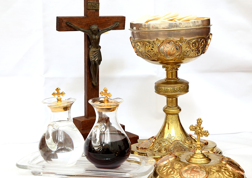The Timeless Significance of Gold in World Religions
Why is gold important in religion?
Gold has been revered across many different cultures and religions for millennia. Long before it was used as currency, it was used in the worship of gods and played an important role in religious ceremonies worldwide, showing devotion and respect for the gods.
The intrinsic qualities of gold—its rarity, beauty, and resistance to tarnish—have made it a symbol of eternity. Also, in many faiths, gold’s lustre often represents purity, light, and the divine, and using gold as an offering or tribute to a deity shows a meaningful sacrifice to show how much the god is valued.
Many ancient civilisations crafted golden statues and religious artifacts to honour their gods. Gold is a powerful and enduring symbol in many religions across the world, representing humanity's desire to connect with higher powers, and is still used in rituals, sacred objects, and architecture today.
Gold in Christianity
In Christianity, gold is seen as much more than a precious metal; it often represents purity, glory, and the majesty of God. Throughout the Bible, gold is mentioned frequently, symbolising wealth as well as a representation of the divine. For example: the story of the three wise men, or Magi, brought gifts of gold, frankincense, and myrrh to the newborn Jesus, with gold symbolising kingship and the divine authority of the son of God.
There are many references to gold throughout the Bible, and its link with purity is featured in many biblical texts. In the Book of Revelation, it describes the streets of the New Jerusalem as paved with pure gold, which is believed to symbolise both beauty and eternal value, illustrating the idea that gold is not only material wealth.
Churches, cathedrals, and chapels often feature gold in their architecture and art. Golden chalices, crosses, and statues adorn many places of worship, and these sacred objects, crafted from or plated in gold, are reminders of God’s glory and the sanctity of the faith.
In Christian art, gold is often used to symbolise divine light and heavenly glory. A material that does not tarnish or corrode, gold’s nature also symbolises the unchanging and eternal nature of God, while references to owning gold and silver in both the Old and New Testaments are compared to the acquisition of knowledge, wisdom, and faith.
Gold in Islam
Islam has a uniquely balanced approach to gold, embracing its beauty and symbolism while also adhering to ethical guidelines and commitment to modesty. Islamic law (Sharia) discusses the use of gold, with several Hadiths (the sayings of the Prophet Muhammad) cautioning against extravagance. Devout Muslim men often refrain from wearing gold jewellery to maintain humility.
Despite this modesty, gold remains an essential element of Islamic culture. It is associated with prosperity, but also its beauty and incorruptibility make it a symbol of purity and the eternal; qualities that Muslims strive for. Ancient religious objects were often made with gold, and it is also widely featured in Islamic art and architecture. The Dome of the Rock in Jerusalem boasts a golden dome, symbolising divine light and guidance, and gold leaf is often used to decorate Qur’ans and other religious texts to emphasise the divine wisdom contained within.
Gold in Hinduism
In Hinduism, gold symbolises purity, wealth, and prosperity, with its luminosity often compared to the radiance of the gods and representing the inner light of spiritual truth. Gold is often given as gifts during religious ceremonies, weddings, and significant celebrations such as Diwali.
Many Hindu deities are depicted adorned with gold jewellery and ornaments, to illustrate their divine status and spiritual wealth. Lakshmi, the goddess of wealth and fortune, is often shown with gold coins flowing from her hands, and Lord Vishnu, the preserver of the universe, is often depicted wearing a golden crown.
Gold often appears in Hindu temples, where it is used in domes, idols, and decorations in order to attract a connection to the divine through vibrations. During Hindu wedding ceremonies, gold rings are exchanged, or a thali necklace is presented to the bride, to signify blessings, partnership, and purity.
Gold in Buddhism
In the Buddhist religion, gold is seen as a reflection of the sun’s pure light, and the incorruptible qualities of gold also symbolise the purity of the Dharma, the teachings of the Buddha which leads practitioners towards enlightenment.
Followers of Buddhism show their devotion and reverence by ceremoniously applying gold leaf to Buddha statues and Buddhist temples. Known as ‘gold rubbing’, this form of worship is thought to make these objects sacred.
The significance of gold in Buddhist philosophy is profound, often appearing as metaphors to represent spiritual purification. Just as gold is purified in fire to reveal its purest form, followers are encouraged to take part in spiritual practices that cleanse their minds. In the Jataka tales, gold represents ultimate truth and ethical behaviour—qualities that ultimately lead to enlightenment.
Gold in Judaism
In Judaism, gold is steeped in historical, spiritual, and religious significance. The Torah tells of gold's importance in building the Tabernacle (the sanctuary and place of worship made by Moses for the Hebrew tribes before their arrival in the Promised Land), and the Temple in Jerusalem. Again, the precious metal symbolises purity, divine wisdom, and an eternal connection with God. The Ark of the Covenant was overlaid with pure gold to signify the sanctity of the commandments within. The Menorah, the candelabrum used during Hanukkah, is often made from pure gold, acting as both a source of light and a symbol of wisdom and spiritual illumination.
The use of gold in sacred objects and temples within the Jewish faith is believed to be of divine command, showing that gold is worth even more than its material value. It acts as a connection to the spiritual realm and shows the importance of beauty, and of reverence in worship.
Gold in ancient religions
Humans have used gold for thousands of years and it is believed to be one of the first metals discovered. Many ancient civilisations linked gold to spirituality and religion, believing that it possessed supernatural powers.
In Ancient Egypt, gold was believed to be the flesh of the gods and was associated with the sun god Ra. This sacred metal represented eternal life, the sun’s power, and the divine authority of kings and queens. Gold was also used in many religious rituals, as offerings to the gods, and to decorate the tombs and burial masks of the pharaohs, as it was believed to protect them in the afterlife.
The Incas viewed gold as the sweat of the sun and used it to create objects like the golden llama, an offering for an Inca mountain god. The Aztecs and Mayans adorned their temples and tombs with gold, reflecting its significance in their religious practices.
The spiritual value of gold in modern times
Throughout history, gold has been seen as a store of value and a symbol of wealth and purity, influencing both society and spirituality.
Its significance in various religions reflects its lasting power as a precious metal. Today, gold is still an important part of many modern religious practices, and often serves as a reminder to followers of the higher powers they worship.
Whether in traditional rituals or modern expressions of faith, gold remains a strong symbol of the divine and of human devotion. As a rare and cherished gift, gold also holds lasting significance. This most precious of metals’ deep connections to many religions around the world give it a spiritual meaning that often goes beyond its monetary value.
This blog represents one person’s opinion only. Please note, gold and silver prices may go down as well as up. Atkinsons Bullion & Coins accepts no responsibility for any losses based on information we have provided. We do not offer investment advice. Please carry out your own research before making an investment decision.















